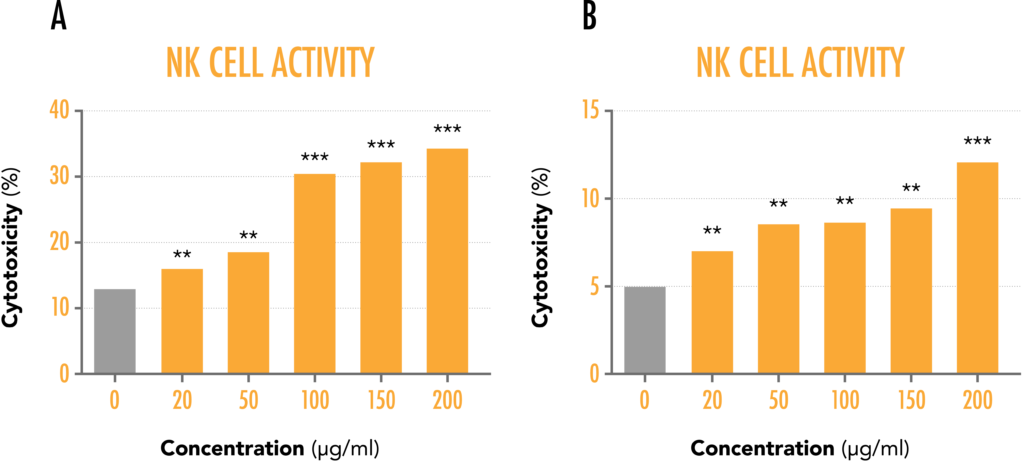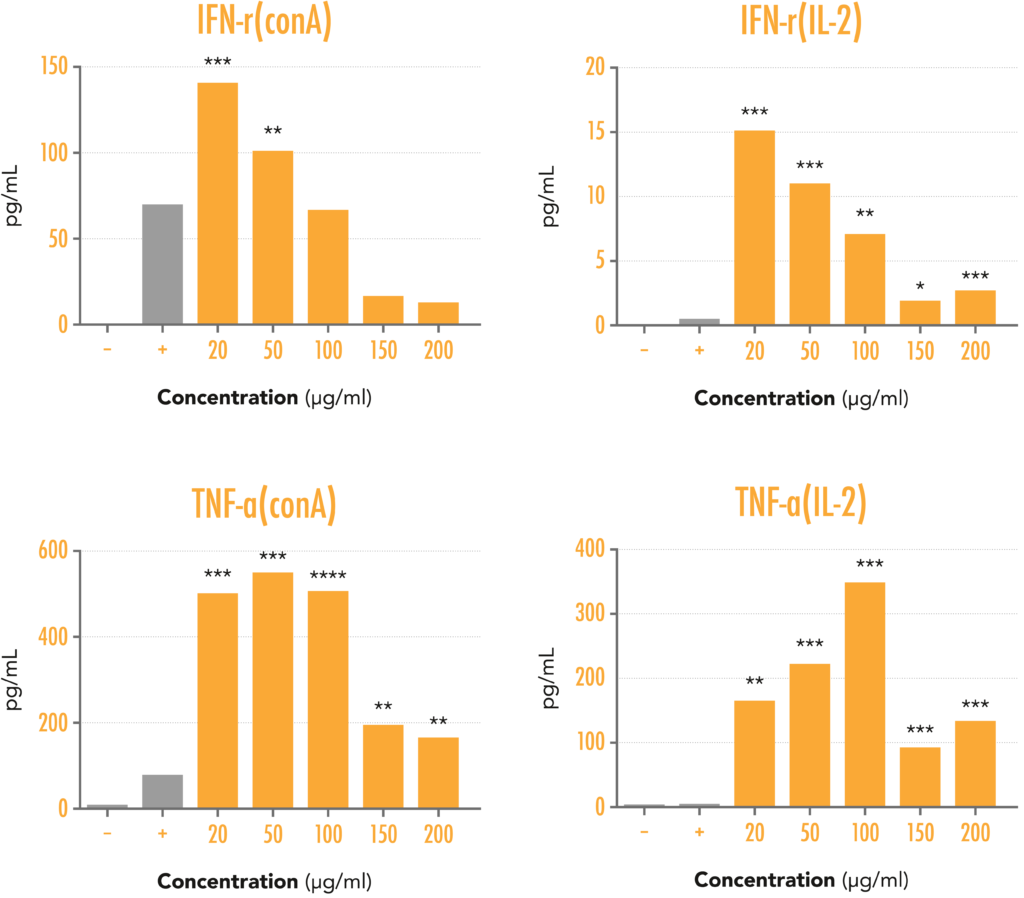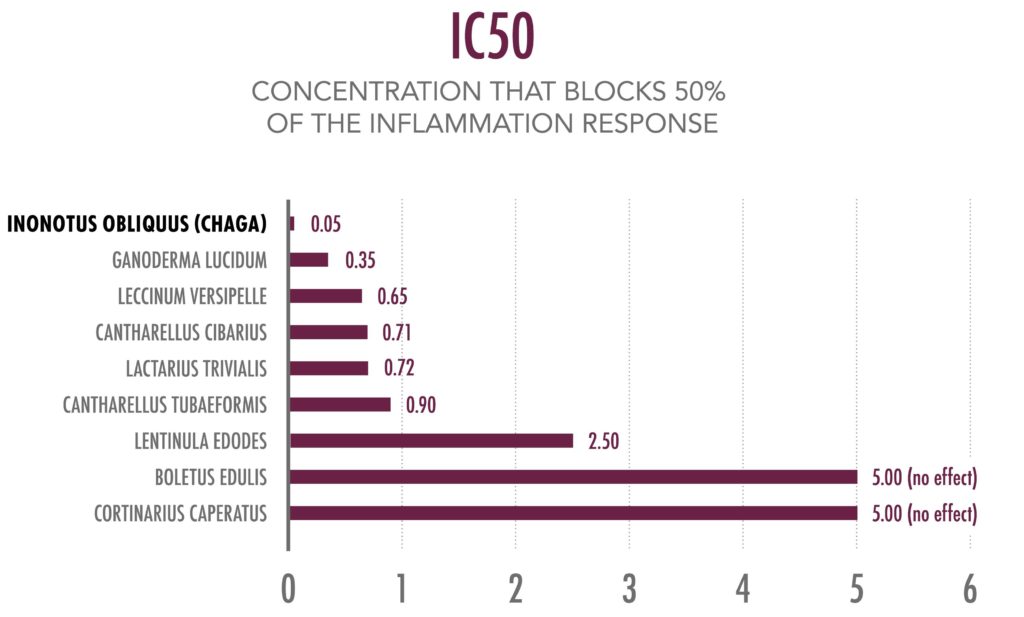Immune health in viral pandemic times
You can download the whitepaper by clicking here.
Feno-Chaga® – A natural immune stimulant with a feel-good sustainable story
By Petri Lackman, Chief Technology Officer, Eevia Health Oy
In these pandemic times, the ability of our body and immune system to fight off pathogens is crucial. People rightfully pay much more attention to the role of the microbiome, the immune system, and problems related to low-grade inflammation and systemic chronic inflammation (SCI)[i].
Important Immune Support
Chaga is a mushroom that, in nature, grows mostly on Arctic birch trees. There is a wide range of products made from Chaga, from a simple crushing of the outer shell of wild-harvested Chaga, called the sclerotium, to highly specialized extracts where specific bioactives are concentrated at high levels. Then there are products made by growing mycelium on substrates in large growth houses, which does not develop the sclerotium and are very different than wild Chaga.
All of these products vary wildly in terms of the composition of bioactives. The sclerotium tissue is unique to the wild-crafted Chaga, and the mycelium inside the conk contains most of the mycochemicals and beta-glucan components typically linked to the Chaga’s health benefits. The rich polyphenol content of the Chaga is also in the sclerotium[1].
Chaga products have been known to have multiple effects in humans. Published research on Chaga and its impact on the immune system and immune health challenges, is starting to become abundant. However, it is necessary to understand the compositional differences of crude Chaga versus extracted Chaga and also the difference between wild-harvested Chaga versus Chaga grown artificially on substrates in-door, to have a meaningful discussion of bioeffects.
The Feno-Chaga® Organic is a high concentrate extract which has shown three main ways in which it influences the immune system:
- Boost T- and B-type lymphocyte activity and proliferation[ii], [iii], company data
- Mediate macrophage phagocytosis and increases IFN-γ and TNF-α production[iv]
- Reduce IgE production during allergenic exposures[v]
Eevia Health is constantly conducting further studies to elucidate how the branded ingredient extract Feno-Chaga® works in humans. A recent study has shown that wild-crafted Feno-Chaga® activates the killing activity of Natural Killer (NK) cells considerably. As the first line of immune defense in an innate immune system, the NK cells’ role is deemed crucial.
NK cells are a class of ubiquitous white blood cells responsible for detecting compromised cells from our bodies due to cancer, viral infection, or some other type of damage. After locating the compromised cell, they will then proceed to destroy it to contain the underlying problem.
Feno-Chaga® has been studied both in vitro (Figure 1, A) and ex vivo (Figure 1, B) with a human NK cell line (NK92MI) and primary NK cells extracted from mice spleen. The preliminary studies showed that while Feno-Chaga® did not have a significant effect on increasing the actual number of splenocytes, it caused a substantial increase in NK cell activity. It indicates that the level of efficacy is independent of the actual amount of NK cells[vi].

Figure 1. NK cell killing activity against target cells
Feno-Chaga® shows substantial NK cell-activating effect already in extremely low concentrations in both human cell models and actual primary NK cells extracted from mice spleens. Feno-Chaga® has also demonstrated effects on the production of Th1-type cytokines, such as IFN- γ and TNF-α.
Together, these two signaling molecules are responsible for the growth regulation of T lymphocytes, induction of macrophage activity, and other immediate responses in both innate and adaptive immune systems.
A study completed in primary splenic lymphocytes shows a dramatic increase of Th1-type cytokines after Feno-Chaga® supplementation in lower concentrations of the extract. In higher concentrations, the native antioxidative and anti-inflammatory effects of the extract begin to overpower the initial immune response and subdue it to an extent.

Figure 2. Feno-Chaga® effect on Th1-type cytokines
In summary, these results show great promise for Feno-Chaga® in the modulation of lymphocytes. These white blood cells are critical in the cellular immune response and how they react in their role as host defense systems for intracellular microbial agents and viruses.
Inflammatory Responses: Reduction of Chronic Inflammation
Inflammation is the immune system’s response to injury and infection. It is the body’s way of signaling the immune system to heal or repair damaged tissue and to fight foreign invaders such as bacteria and viruses. Although inflammation is a part of the body’s defense mechanism, chronic low-grade inflammation can be a severe risk factor for many other health challenges. These challenges include cardiovascular decline, blood sugar control, joint and bone health, allergies, and chronic pulmonary issues. In a pre-clinical trial, Feno-Chaga® suppressed this kind of perpetually activated and chronic state of inflammation in neutrophils, the most abundant class of white blood cells in our bodies. Neutrophils are phagocytic cells that destroy other cells by chemical reactions, where they secrete reactive oxygen species and hydrolytic enzymes to their target cells. These reactions are a perfectly normal part of our immune system but are also responsible for over half of the reactive oxygen species that enter our bodies, so it’s easy to see how chronic state of this activity can be harmful in the long run.
In an earlier study, it appeared that Feno-Chaga® can deactivate neutrophils, which have been induced to a chronic inflammation state, back to a normal, resting, non-inflammation state. This effect can be seen from the results illustrated in Figure 3. Interestingly, when the product was introduced to neutrophils in a resting state, Feno-Chaga® had a minor activity-inducing effect on them. This induction effect is in line with the results from the previous chapter supporting the findings that Feno-Chaga® can boost the immediate immune responses.

Figure 3. Feno-Chaga® effect on low-grade chronic inflammation through reduction of myeloperoxidase (MPO) activity of human neutrophil cells
Comparison of MPO activity of neutrophils in various Feno-Chaga® concentrations showed a complete inactivation back to baseline levels in higher concentrations (100 µg/ml) and an increase in baseline activity in lower concentrations (25 µg/ml). Data from a pre-clinical study of eight (8) healthy volunteer blood samples.
In addition to this study, see the comparative effect of chaga versus other popular medicinal mushrooms on suppressing the same type of inflammation (Figure 4), where chaga extract is significantly more effective than other medicinal mushrooms. This effect thus might be unique to wild-crafted chaga.
In this figure (4), IC50 represents a concentration of extract that can block 50% of the neutrophil inflammation response after activation to a simulated chronic inflammation state. It can be easily seen that chaga extract is considerably more potent than any other medicinal mushroom at achieving the required 50% inhibition level.

Figure 4. Comparison of various medicinal mushroom extracts on reduction myeloperoxidase (MPO) activity of human neutrophil cells
Eevia Health is also currently undertaking another comparative study on low-grade inflammation in human blood cells. This new study is comparing wild-crafted Feno-Chaga® to other commercial chaga extract products, including cultivated chaga grown on mycelium substrates like grain or soy, and other reputed supplement ingredient products with anti-inflammatory claims, such as curcumin. The data is expected to come in May 2020 and will possibly further substantiate the unique ability of Feno-Chaga® to reduce low-grade inflammation in our blood cells.
It is quite evident that Feno-Chaga® is unlike other chaga ingredients. Nutraceutical brands using Feno-Chaga® as an ingredient in their Immune-products will position that product at the top of the category. The story behind the organic forest, wild-crafted/harvested, clinical effects, 100% traceability (from the forest to the product), and unparalleled quality, conspire to set Feno-Chaga® out from the crowd! What more would a consumer want?
History
It would be wise to give a quick recap on the “King of the Medicinal Mushrooms.” The first mention of the use of Chaga dates back to the 16th century, and its use in Russia. Chaga was used in a variety of ways, including general well-being, internal cleansing, and curing and preventing diseases in general.[vii] In Finland, people have used chaga for centuries against common cold, infections, to boost immunity, and for maintaining good health.
What is Chaga?
Chaga is a parasitic fungus belonging to the genus Inonotus. In Latin, Inonotus means to penetrate, which reflects the reproductive nature of Chaga’s spores. After the spores enter a wound or crevice of a tree, the mushroom begins to grow inside the tree. The growth-process may take decades before any sign of chaga is visible from the outside of the tree. In Finland, where Feno-Chaga® is harvested and made, chaga infects only 1 out of 10,000 trees.
Understanding what chaga looks like and the harsh environment where it naturally grows provides insight into why it is often referred to as “the king of the mushrooms.” Chaga is also known as “Black Mass”, which accurately describes its appearance when it grows in the wild. The exterior is a hard, dark black conk, and roughly textured, while the inside is of the orange color and similar to cork in texture. Wild chaga primarily grows on birch trees in the arctic and sub-arctic forests, where the cold environment is thought to contribute to its health benefits through elicitation of a unique kind of metabolism required for chaga to survive in that kind of conditions.
The conk is a growth of the chaga mycelium. It is the outer shell called the sclerotium. Sclerotium tissue is unique to the wild-crafted chaga, and the fungus grows this to survive the harsh environment of the Arctic regions. The conk is the only part of the wild-crafted chaga, which is harvested.
The mycelium inside the conk contains most of the mycochemicals and beta-glucan components typically linked to the chaga’s health benefits. However, it should not be forgotten that most of the rich polyphenol content of the chaga is in the sclerotium[2].
Why do you “feel good” when consuming chaga? Generally speaking, the research on chaga shows the benefits of the mushroom in many areas of health, including; immune support[viii], blood sugar[ix], inflammation[x], cardiovascular[xi], oxidative stress[xii] , and radioprotective[xiii]. Chaga contains phytochemical compounds such as beta-glucans, polysaccharides, triterpenes, polyphenols, melanins, betulin, and betulinic acid[xiv]. These phytochemicals possess unique biochemical and physiological benefits to health. Betulin and betulinic acid are unique to chaga grown on birch trees due to those compounds being primarily found in birch trees.
Why is Feno-Chaga® Different than other Chagas?
There are several areas in which Eevia Health’s Feno-Chaga® sets itself apart and above other chagas;
- Wild-crafted, not cultivated or grown on grain
- Grown in the world’s largest certified organic forest
- Clinically proven immune support
- Clinically proven Inflammatory response
- 100% traceability (from the forest to the product)
- Unparalleled quality (NO radioactivity, pesticides, PAHs, etc.)
Wild-crafted, not Cultivated
Wild-crafted plants grow wild, precisely as the name implies. In the case of Feno-Chaga®, it grows in organic forests in the northern part of Finland without any human intervention. The mushrooms are subjected to environmental stressors such as variations in sunlight, extreme temperatures, the availability of water, competing plants, and other stress factors. Growing wild forces chaga to become more resilient and fully develop the nutrients and phytonutrients derived from the host tree. Proper harvest by hand, also ensures the removal of proper amounts of the mycelium. This technique allows the tree to remain alive and for the mushroom to grow back. Harvesting in this manner means chaga can be harvested again from the same spot in 3–5 years. Assuming the average tree will live up to 20 years once infected with Chaga, harvesting can be done multiple times in one location.
Chaga that is harvested from the tree is a sterile conk of mycelium and sclerotium, not the actual fruiting body of the chaga. The biggest argument for chaga sustainability is that the fruiting body is not harvested at all! Chaga grows fruiting body only after the host tree has died, so traditional harvesting of chaga conks does not touch the normal reproductive cycle of chaga.
While discussing harvesting in the wild, the topic of sustainability comes up. Most people would think that since only a small percentage of trees (1 in 10,000) are infected with chaga, the supply of chaga is limited in Finland. In reality, it is very sustainable due to the large volume of trees in Finnish forests. Consumer demand only requires the harvesting of a small portion of the chaga available. The mushroom is collected by local forest stewards that care deeply about the health and sustainability of their forests. According to the most recent information about forest resources in Finland, the total volume of growing stock on the forest land and poorly productive forest land is 2,464 million cubic meters, of which 17% are birch trees.
As mentioned earlier, Feno-Chaga® is exclusively grown on birch trees. Birch trees are responsible for providing many of the bioactive components that make chaga special. The cultivation of medicinal mushrooms has been on the rise over the past several years. Being able to grow mushrooms inside in a controlled environment offers several appealing benefits: the mushrooms grow quicker and cost less to produce. While cultivating most medicinal mushrooms sounds excellent, it isn’t the best method for chaga. Chaga cultivation leads to the reduced and notably different production of metabolites[xv] than chaga grown in the wild. Cultivated chaga has:
- Reduced number of phytosterols[xvi]
- Reduced concentration of active compounds (beta-glucans, polyphenols)
- Reduced bioactivity through a lower pool of active compounds
- A significantly higher concentration of starch, which shows up as polysaccharides in more simple analytical methods, such as spectrophotometric methods
- Not the sclerotium shell which wild-crafted chaga has. It is this shell, which contains the polyphenolic fraction with exceptionally high antioxidative properties.
Buyer Beware:
Many Chaga supplements only list” chaga mycelium” or “myceliated brown rice.” This declaration means that the material is not sourced from wild chaga growing on Birch trees. As follows, such mushroom material does not have the same medicinal profile as wild-grown Chaga.
Grown in the World’s Largest Certified Organic Forest
Yes, wild versus cultivated is a great story, but what if your chaga grows in the world’s largest organic forest? Feno-Chaga® does! Feno-Chaga® raw materials grow in the world’s largest certified organic collection area; the forests of Finland accounting for 30 percent of the world’s total organic collection area. 99% of the Finnish forests in the Arctic region are organic certified. The organic certification of wild, raw materials gives the assurance of the origin, authenticity, traceability, and guarantees that the biodiversity of the wild forest environment is maintained. The ingredient manufacturing company is required to prepare a detailed organic plan identifying harvest areas and harvesters. To harvest in this region of Finland, one has to make a registration with the organic control authority and ensure continuous compliance with the terms and conditions of organic production.[xvii]
In summary, natural standardized chaga extracts offer numerous protecting benefits to the human body and supports a healthy immune system.
References
[1] Company analytical data
[2] Company analytical data
[i] Furman, D., Campisi, J., Verdin, E. et al. Chronic inflammation in the etiology of disease across the life span. Nat Med 25, 1822–1832 (2019). https://doi.org/10.1038/s41591-019-0675-0
[ii] Kim YO, Han SB, Lee HW, et al. Immuno-stimulating effect of the endo-polysaccharide produced by submerged culture of Inonotus obliquus. Life Sci 77, 2438–56 (2005). https://doi.org/10.1016/j.lfs.2005.02.023
[iii] Chen Y, Huang Y, Cui Z, Liu J. Purification, characterization and biological activity of a novel polysaccharide from Inonotus obliquus. Int J Biol Macromol. 79, 587-94 (2015). https://doi.org/10.1016/j.ijbiomac.2015.05.016
[iv] Fan L, Ding S, Ai L, Deng K. Antitumor and immunomodulatory activity of water-soluble polysaccharide from Inonotus obliquus. Carbohydr Polym. 90, 870–4 (2012). https://doi.org/10.1016/j.carbpol.2012.06.013
[v] Ko SK, Jin M, Pyo MY. Inonotus obliquus extracts suppress antigen-specific IgE production through the modulation of Th1/Th2 cytokines in ovalbumin-sensitized mice. J Ethnopharmacol. 137, 1077–82 (2011). https://doi.org/10.1016/j.jep.2011.07.024
[vi] Unpublished company data from a pre-clinical study done with a third party CRO in South-Korea
[vii] Oriveda Website, Chaga the Facts, https://oriveda.wordpress.com/chaga-the-facts/#h-3 Last revision: July 5th, 2016, accessed March 4, 2020
[viii] Kim YO, Han SB, Lee HW, et al. Immuno-stimulating effect of the endo-polysaccharide produced by submerged culture of Inonotus obliquus. Life Sci 2005;77(19):2438-56
[ix] Sun JE, Ao ZH, Lu ZM, et al. Antihyperglycemic and antilipidperoxidative effects of dry matter of culture broth of Inonotus obliquus in submerged culture on normal and alloxan-diabetes mice. J Ethnopharmacol 2008;118(1):7-13
[x] Park YM, Won JH, Kim YH, et al. In vivo and in vitro anti-inflammatory and anti-nociceptive effects of the methanol extract of Inonotus obliquus. J Ethnopharmacol 2005;101(1-3):120-8.
[xi] Hyun KW, Jeong SC, Lee DH, et al. Isolation and characterization of a novel platelet aggregation inhibitory peptide from the medicinal mushroom, Inonotus obliquus. Peptides 2006;27(6):1173-8
[xii] Lee IK, Kim YS, Jang YW, et al. New antioxidant polyphenols from the medicinal mushroom Inonotus obliquus. Bioorg Med Chem Lett 2007;17(24):6678-81
[xiii] Rasina LN. [Effect of cryosubstance Chagi on deposition or isolation of 90Sr and on the effect of prolonged external exposure to gamma-radiation]. Radiats Biol Radioecol 2002;42(4):399-403.
[xiv] Géry A, Dubreule C, André V, et al. Chaga ( Inonotus obliquus), a Future Potential Medicinal Fungus in Oncology? A Chemical Study and a Comparison of the Cytotoxicity Against Human Lung Adenocarcinoma Cells (A549) and Human Bronchial Epithelial Cells (BEAS-2B). Integr Cancer Ther. 2018;17(3):832–843. doi:10.1177/1534735418757912
[xv] Zheng W, Miao K, Liu Y, Zhao Y, Zhang M, Pan S, et al. (2010). “Chemical diversity of biologically active metabolites in the sclerotia of Inonotus obliquus and submerged culture strategies for up-regulating their production.” Applied Microbiology and Biotechnology. 87 (4): 1237–54
[xvi] Zheng, W. F.; Liu, T.; Xiang, X. Y.; Gu, Q. (July 2007). “Sterol composition in field-grown and cultured mycelia of Inonotus obliquus.” Yao Xue Xue Bao = Acta Pharmaceutica Sinica. 42 (7): 750–756
[xvii] Luke website, https://www.luke.fi/ruokafakta/en/vegetables-fruits-and-berries/organic-collection-area/ , Organic collection area., Accessed March 7, 2020.